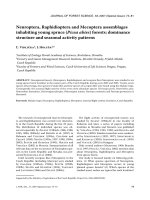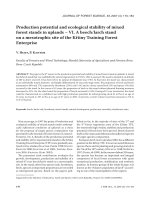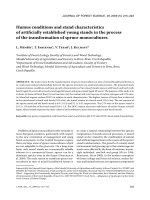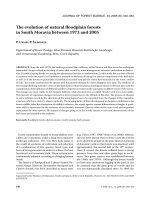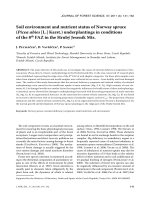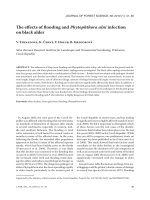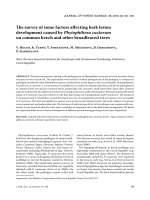Báo cáo lâm nghiệp: "The persistence and function of living roots on lodgepole pine snags and stumps grafted to living trees." pdf
Bạn đang xem bản rút gọn của tài liệu. Xem và tải ngay bản đầy đủ của tài liệu tại đây (700.7 KB, 6 trang )
Ann. For. Sci. 64 (2007) 31–36 31
c
INRA, EDP Sciences, 2007
DOI: 10.1051/forest:2006085
Original article
The persistence and function of living roots on lodgepole pine snags
and stumps grafted to living trees
Erin C. F, Victor J. L
*
, Simon M. L
¨
Centre for Enhanced Forest Management, department of Renewable Resources, university of Alberta, Edmonton, Alberta, Canada T6G 2E3
(Received 16 May 2006; accepted 27 June 2006)
Abstract – In Alberta, Canada, pairs of grafted lodgepole pine trees were selected to study the longevity and location of live roots of snags that were
grafted to living trees, to determine the impact of these live residual roots on the diameter growth of the living tree. In a second study, dense groups of
grafted trees were manually thinned and one leave tree was left to grow for two growing seasons. For both studies, roots were excavated. Results indicate
that more live roots were maintained on snags connected to living trees with a large graft and that roots located within 90
◦
of the root grafted to the live
tree persisted longer. Also, tree ring index in the living trees significantly increased following manual thinning, but was unaffected when the grafted
partner died naturally. Grafts with large phloem connections maintained a higher number of live roots on snags, than grafts with small connections.
root graf t / snag / manual thinning / competition / lodgepole pine
Résumé – Persistance et f onctions de racines de souches de Pinus contorta présentant des anastomoses avec des arbres viv ants. En Alberta
(Canada), de couples d’arbres (Pinus contorta) présentant des anastomoses racinaires ont été sélectionnés pour étudier la longévité et la disposition des
racines de souches connectées à des arbres vivants, et préciser l’impact des ces racines résiduelles sur la croissance en diamètre de l’arbre vivant. Dans
une seconde étude, des bosquets denses d’arbres anastomosés ont été éclaircis manuellement, et les arbres conservés ont été coupés après deux saisons
de végétation. Les résultat indiquent que sur ces souches connectées à des arbres vivants, de nombreuses racines ont survécu ; de plus, les racines
présentes dans un secteur de 90˚ par rapport à une anastomose avec l’arbre vivant, persistent nettement plus longtemps sur ces souches que les autres.
De plus, la croissance des cernes d’arbres vivants augmentait fortement suite à l’éclaircie, mais pas suite à une mort naturelle de l’arbre partenaire
anastomosé. Les anastomoses avec de fortes connections au niveau du liber ont permis de maintenir en vie un plus grand nombre de racines sur les
souches que celles avec de faibles zones de contact.
greffederacine/ chicot / éclaircie manuelle / compétition / Pinus contorta
1. INTRODUCTION
Living roots on dead trees (snags) and stumps connected
to living trees with a root graft are a common occurrence in
many coniferous forest stands (e.g., [3,7,9,12,18]). Following
the death of individual trees (either from natural causes or cut-
ting), the base of the stem and the root systems of the remain-
ing snags and stumps can be kept alive through the transfer of
carbohydrates via root grafts from living neighbouring trees
(e.g., [4,16]). Stumps not grafted to living trees can persist for
up to one growing season after removal of the photosynthe-
sizing tops [3], but survival beyond one year has always been
attributed to photosynthate transferred across root grafts from
living trees (e.g., [3, 7, 12,16, 18]).
There have been several studies that have assessed the sur-
vival rates of above-ground portions of snags and stumps fol-
lowing removal of the crown (e.g., [3, 7, 12, 15, 16]). How-
ever, there have been no replicated studies that investigated the
longevity or mortality patterns of the root systems of stumps
or snags grafted to living trees. While there have been stud-
ies of transfer of resource through root graft of living trees
* Corresponding author: victor.lieff
[10] it is currently unclear whether the transfer of resources
to living stumps or snags affects the diameter growth of liv-
ing grafted partners. There have been reports of significantly
increased growth [4], decreased growth [7] and no change
in growth [19] in living trees grafted to living stumps rela-
tive to non-grafted control trees. Also, previous studies have
not differentiated between the effects of a grafted partner dy-
ing gradually from natural causes (e.g., competition) or sud-
denly following manual cutting. When a tree is suppressed
by its neighbours, death may take several years and the sup-
pressed tree may slowly drain resources from its grafted part-
ner [10]. Conversely, relatively healthy grafted partners may
be killed suddenly via manual thinning; under these circum-
stances, above-ground parts would not be a potential sink for
resources but a large grafted root system could become a sud-
den drain of resources. This may be a cause for the slow
release following thinning which has been reported in some
studies [8,11].
Lodgepole pine (Pinus contorta var. latifolia Dougl. ex
Loud.) was selected for this study because it has been pre-
viously shown to readily form root grafts, especially af-
ter 15 years of age [9]. Also, lodgepole pine is a shade
Article published by EDP Sciences and available at or />32 E.C. Fraser et al.
intolerant species that has a tendency to form extremely
dense single-species stands following natural disturbances
[13]. Therefore, many lodgepole pine stands are manually
thinned during the juvenile stages [13]. As a result, it is likely
that dense lodgepole pine stands undergoing self-thinning are
composed of living trees grafted to at least one snag or stump
with live roots.
The objectives of this study were to determine the longevity
and location of live roots on lodgepole pine snags and stumps
grafted to living trees and to determine whether these live roots
affect the diameter growth of living trees.
2. MATERIALS AND METHODS
2.1. Natural mortality study
This study used plots established within a large, pure fire-origin
lodgepole pine forest near Hinton, Alberta (53
◦
23’ 60” N; 117
◦
34’
60” W). Live trees in the study area averaged 8.1 cm in stem diameter
(range: 5.7–11.8 cm, measured at 10 cm height) and 45.1 years of age
(range: 39–54 years, measured at 10 cm height). Dead standing trees
(snags) in the study area averaged 4.9 cm in stem diameter (range:
2.8–7.0 cm, measured at 10 cm height), 31.9 years of age (range:
22–39 years, measured at 10 cm height) and had been dead for an
average of 14.7 years (range: 8–23 years, measured at 10 cm height)
(see below). As there was no evidence of root rots, stem decay or
reports of defoliating insects, we assumed that trees died of natural
suppression. Trees were taken from flat or slightly inclined terrain
and soils were Brunisolic Grey Luvisols.
Twenty pairs of trees were located in August 2004. Each pair con-
tained one living tree and one snag (completely dead above ground)
connected with a root graft. Trees were within 30 cm of each other
and were presumed to be grafted together prior to the death of the
snag. The grafted pair was at least 80 cm from other trees; trees
spaced > 80 cm apart had low probability of being grafted [9]. All
pairs were located at least 20 m apart. The root system of each tree
pair was manually excavated with spade and pulaski to a depth of
30 cm and the grafting status was verified. The grafted stumps and
large roots were removed intact from the ground and transported to
the laboratory for analysis.
Stem diameter and tree age were measured on all trees on a stem
section taken at 10 cm height. Tree ring widths were measured on the
stem sections with a Parker Instruments
stage micrometer (Vickers
Instruments York, England) and dissecting microscope. Starting with
the outermost ring, each ring was counted and the relative width of
each tree ring was noted. A master chronology of the relative size of
annual rings for each calendar year was determined from the living
trees. Calendar years were then assigned to rings in the snags by com-
paring the patterns of relative ring size in living trees with their dead
grafted partners [17, 20]. From this analysis, the year of death (de-
fined as the date of the last annual ring) was established for all snags.
This assumes that there were no missing rings in years with very slow
growth prior to death. Also, all grafted roots were removed from the
grafted root system, glued to a board and then serial sectioned with a
band saw into 0.25–0.50 cm thick sections. The sections were either
sanded or carefully shaved with a razor blade prior to examination
of the annual rings. Graft sections were examined and the age of the
graft, the area of the xylem across the graft and the circumference of
the phloem across the graft were measured and recorded. Most of the
xylem area of these roots was sapwood. The grafted circumference of
the phloem was assumed to be the length of the bark/phloem contact
between the two roots, around the graft.
Tree ring index (TRI) of the stem was also determined for each
live tree. To calculate TRI, annual ring widths were plotted for each
calendar year. The highest growth peak at least ten years prior to the
death of the snag was identified. An exponential function was then
fitted to data for each tree starting at this growth peak and ending
the year that the snag died. This exponential function was used to
extrapolate the expected ring widths after the death of the snag. Tree
ring index was calculated by dividing the observed ring widths by
the expected ring widths for the two years immediately following the
death of the snag [6]. Also, in order to determine the survivorship of
roots relative to the position of the graft, the radial positions of all live
and dead coarse roots (> 1 cm diameter), on each snag were recorded
relative to the position of the graft. Roots were categorized as < 90
◦
or > 90
◦
from the grafted root.
2.2. Manual thinning study
All trees were selected from areas at least 50 m apart within three
general areas containing pure fire-origin lodgepole pine, near Swan
Hills, Alberta (54
◦
45’ 12” N; 115
◦
42’ 14” W). Trees in the study
area averaged 5.7 cm in stem diameter (range: 2.2–12.5 cm, measured
at 10 cm height) and 19.9 years of age (range: 16–30 years, measured
at 10 cm height). Sites had less than 10% slope and the soils were
Grey Luvisols.
Eight plots (ranging in size from 1–4 m
2
), each containing
3–6 trees, were established in May 2003. Plots were located
in areas with local clumps of trees with high stem densities
(> 25 000 stem ha
−1
) because these areas have been shown to have a
high probability of root grafting [9]. Clumps were separated from ad-
jacent trees by at least 1 m. At each plot, a dominant or co-dominant
leave tree in the centre of the clump was selected and the surround-
ing trees were cut with a brush saw. Trees selected as leave trees
were healthy and had good form. Plots were located at least 20 m
apart. Also, eleven dominant/co-dominant non-grafted control trees
were selected from the area surrounding the study plots; these trees
were locally isolated from other trees by > 80 cm but not more than
150 cm. Trees of this size and proximity have a very low probabil-
ity of being grafted to another individual [9] and this was verified by
excavation. Stems were cut and the stem sections were transported to
the laboratory. Although the local densities around the treated trees
(clumps) and control trees (single stem) were not similar in this study,
the densities at a somewhat larger scale (e.g. 2+m radius) surrounding
the focal tree or clump were similar.
In August 2004, two growing seasons after the thinning treat-
ment, all plot areas were excavated to a depth of approximately 30–
40 cm so that all lateral roots were exposed. Following excavation,
the grafted/non-grafted status of all plot trees was determined. The
stumps and large roots of all trees grafted to the leave tree were re-
moved intact from the ground and transported to the laboratory for
analysis. Any stumps not grafted to the leave tree were eliminated
from the study.
Stem diameter, tree age and tree ring widths were measured and
recorded on the leave trees, control trees and the stumps of trees re-
moved during the manual thinning treatment. The position of all liv-
ing and dead coarse roots (> 1 cm) on each stump was also recorded.
Further, tree ring index (TRI) was calculated for the leave trees and
the non-grafted control trees in the same manner as described above.
Persistence of live roots on snags and stumps 33
Figure 1. Relationship between the percentage of living roots
on snags and the circumference of the phloem connection of the
graft connecting the snag to a living tree in the natural mortality
study. Note that in some cases, the phloem circumference re-
ported was the total of more than one graft connecting the two
trees.
All grafts were removed from the grafted system and were serial sec-
tioned into 0.25–0.50 cm thick sections so that graft age, graft xylem
area and graft phloem circumference could be determined.
Carbohydrate concentrations of the roots were sampled in order to
determine the rate of decline of C reserves in the roots of cut trees.
Immediately following excavation, samples of living roots from leave
trees, control trees and stumps were collected. Roots collected for car-
bohydrate analysis were 1–2 cm in diameter and were > 45
◦
from the
root grafted to the living tree. All root samples (xylem and phloem
tissues) were dried, ground with a Wiley mill and after soluble sugars
were extracted from the tissue with hot ethanol (85%), their concen-
trations were determined colorimetrically using phenolsulfuric acid.
Starch in the tissues was hydrolysed using an enzyme mixture of α-
amylase and amyloglucosidase and then measured colorimetrically
using glucose oxidase/peroxidase-o-dianisidine solution [5].
2.3. Statistical analysis
The relationship between the percentage of live roots on the snag
or stump and the circumference of the phloem across the graft was
analyzed with linear regression. Linear regression was also used to
evaluate the relationship between the percentage of live roots on the
snag and the time since snag death in the natural mortality study. Be-
cause all stumps had been dead for two years in the manual thinning
study, this relationship was not tested in this study. Also, the relation-
ships between tree ring index (TRI) and stem diameter of the snag or
stump, age of the snag or stump, area of the xylem across the graft,
circumference of the phloem across the graft, age of the graft and
the percentage of live roots on the snag or stump were analyzed with
multiple linear regression. The relationships between the age of the
graft and graft xylem area and graft phloem circumference were an-
alyzed with linear regression. If a tree pair was connected by more
than one graft, the xylem area or phloem circumference of all grafts
was summed so that the total xylem area or phloem circumference
connecting two trees was analyzed.
The data describing the positions of the living roots on the snags
or stumps was analyzed with chi-square analysis. The root sugar and
starch concentrations in leave trees, stumps and control trees were
analyzed with a completely randomized one-way ANOVA and the
changes in TRI before and after the death of a grafted partner were
analyzed with paired t-tests.
All data in both the natural mortality and manual thinning studies
conformed to the assumptions of normality and equality of variance.
Release 8.1 of SAS
(SAS Institute Inc. Cary, NC) was used for all
analyses, multiple comparisons were done with lsd tests and a signif-
icance level of α = 0.05 was used for all response variables.
3. RESULTS
In the natural mortality study, the percentage of live roots
on snags grafted to living trees was correlated with the circum-
ference of the phloem connection across the graft (P = 0.002,
R
2
= 0.521). In this study, virtually all snags with live roots
were connected to a living tree with a graft phloem circum-
ference of at least 20 cm (Fig. 1). If roots were alive on the
distal side of the stump there was living phloem on at least
part of the stump of the snag. We did not, however, observe
a significant relationship between the percentage of live roots
and graft phloem circumference in the manual thinning study
(P = 0.471). Two years after manual thinning, approximately
33% of roots originating from the stump were alive regard-
less of the size of the graft phloem circumference. There was
also no significant relationship between the percentage of live
roots on the snag and the time that the snag had been dead
in the natural mortality study (P = 0.222). Nevertheless, we
did not observe any live roots on snags that had been dead for
longer than 15 years.
In the natural mortality study, the positions of live roots on
the snag were significantly affected by proximity to the graft
with the living tree (P = 0.005). In this study, 83% of live
roots on the snag were located within 90
◦
of the root graft with
the living tree (Fig. 2). However, in the manual thinning study
there were no significant differences in number of living roots
on the near vs. far side of the stump two years after manual
thinning (P = 0.140, Fig. 2).
Tree ring index (TRI) of the leave trees in the manual thin-
ning study significantly increased following removal of the
surrounding grafted partners (P = 0.002, Fig. 3). Prior to thin-
ning, leave tree TRI averaged 1.00 and this value increased to
1.35 in the two years following thinning. Over the same two
time periods, the TRI of control trees was not significantly dif-
ferent from the TRI of leave trees in the two years prior to thin-
ning (P = 0.212, Fig. 3), but was significantly lower than the
thinned plots in the two years immediately following thinning
34 E.C. Fraser et al.
Figure 2. Number of living roots per tree on snags and stumps in
the natural mortality and manual thinning studies. Living roots on the
stumps or snags were placed into two categories; those located < 90
◦
from the point of attachment of the grafted root and those > 90
◦
from
the point of attachment.
Figure 3. Tree ring index during 2001–2002 (before thinning) and
2003–2004 (after thinning) in live trees that had their grafted partners
removed (manual thinning) and in trees that received no treatment
(control). Bars represent the standard error of the mean. Bars with
different letters are significantly different at the 95% confidence level.
Data for 2001–2002 and 2003–2004 were analyzed separately.
(P = 0.005, Fig. 3). In the natural mortality study, TRI in the
living trees was not significantly affected by the death of their
grafted partner (P = 0.205), increasing from 1.00 to 1.04 after
the death of the partner.
Following the death of roots directly grafted to the roots of
living trees, the living root appeared to distinctly wall-off the
xylem connecting it to the dead root (Fig. 4). In some circum-
stances, there was some staining of living roots through the
grafted area, but there was no evidence of decay. There was
also no evidence of any callus tissue formation on the exposed
stump or snag surfaces in either the natural mortality or man-
ual thinning studies. However, all stumps with live roots in the
manual thinning study had formed a resin cap on the exposed
stump surface two years after thinning.
No significant differences were detected in the slope or in-
tercepts between the xylem area of grafts and graft age or the
phloem circumference of grafts and graft age in the natural
mortality and manual thinning studies (P > 0.478), so the
Figure 4. Photographs of root grafts between live and dead roots
where there was no discolouration in the live root following the death
of the dead root (A) and where there was some discolouration in the
live root following the death of the dead root (B). The bark pocket
and callus tissue denote the point of graft formation.
two studies were combined for this analysis. Both graft xylem
area (P < 0.001, R
2
= 0.189) and graft phloem circumference
(P < 0.001, R
2
= 0.210) increased with increasing graft age
(Figs. 5A and 5B). However, no significant relationships were
detected between TRI and diameter of the snag or stump, age
of the snag or stump, graft xylem area, graft phloem circum-
ference, age of the graft or the percentage of live roots on the
snag or stump (P > 0.100) in either the natural mortality or
manual thinning studies.
In the manual thinning study, starch concentrations in the
roots of leave trees and control trees were significantly higher
than in living roots on stumps (P = 0.016). On average, starch
concentrations were 2.7 times higher in roots from leave trees
and control trees relative to those from stumps (2.7% vs. 1.0%,
Fig. 6). However, sugar concentrations in the live roots of
leave trees and control trees were not significantly different
from the sugar concentrations in stump roots (P = 0.286); two
years following thinning, sugar concentrations averaged 3.7%
(Fig. 6).
Persistence of live roots on snags and stumps 35
Figure 5. Relationship between graft age (years since grafting)
and graft xylem area (A) and phloem circumference across the
graft (B). These relationships include data from both the natural
mortality and manual thinning studies.
Figure 6. Sugar and starch concentrations in living roots of stumps,
leave trees and control trees in August 2004. The stumps were from
trees cut two growing seasons previously during a manual thinning
treatment, the leave trees were grafted to the stumps and the control
trees were non-grafted and undisturbed. Bars represent the standard
error of the mean. Bars with different letters are significantly different
at the 95% confidence level. Data for sugar and starch were analyzed
separately.
4. DISCUSSION
Our study demonstrates that the number of live roots sus-
tained on snags grafted to living trees was related to the size
of the phloem connection across the graft. In fact, virtually
all snags with live roots were grafted to a living tree with
a phloem circumference of at least 20 cm across the graft
(Fig. 1). Logically, grafts with larger phloem pathways should
be able to transport greater quantities of carbohydrates to the
snag or stump root system, which should allow for greater root
longevity. Indeed, previous research has indicated that greater
quantities of starch were transferred from non-shaded trees to
their deeply shaded partners via root grafts when the phloem
circumference of the graft was large [10].
In the natural mortality study, we did not detect a signifi-
cant relationship between the proportion of live roots on snags
grafted to living trees and the length of time that the snag had
been dead. However, given the fact that there were relatively
few roots on the distal side of the snag, there had to have been
significant mortality of roots on this side relatively soon after
mortality. Further, most of the phloem in the stump of snags
seemed to die relatively soon after death of the above-ground
portion. Previous studies of the longevity of above-ground
portions of stumps following partial cutting or other distur-
bances have reported that species that form callus tissue over
the exposed stump surface soon after death survive longer. The
callus tissue produced by Douglas fir (Pseudotsuga menziesii
(Mirb.) Franco) and true firs (Abies spp.) appear to allow bet-
ter protection from fungal and insect attacks than the simple
resin cap produced on exposed stumps of eastern white pine
(Pinus strobus L.), ponderosa pine (Pinus ponderosa Dougl.
ex Laws.) [3, 12, 14, 15] and lodgepole pine (this study). We
did not observe any callus tissue formation in either our natu-
ral mortality or manual thinning studies and based on previous
work, callus tissue formation appears to be rare in most pine
species [3,12,15,16]. Considering that the stump is the critical
junction point for the graft to access more distal roots, decom-
position of the stump by saprophytic fungi would break the
transport of carbohydrates and/or water through the stump and
the growing tips of more distal roots would be cut off from
the living tree This theory of how roots die is further strength-
ened by the fact that there was little evidence of pathogens
36 E.C. Fraser et al.
invading the graft of these trees prior to the final death of the
snag or stump root (Fig. 4, P. Blenis, pers. observ.), suggest-
ing that the final cause of death was more distal than the graft
itself. The partial discolouration of the xylem in some grafts
is likely saprophytic fungi as the discoloured tissue in the live
roots was always solid. Interestingly, even after several years
of graft connection, the boundary between live and dead tis-
sue appeared to be defined by the lines of the original roots
(Fig. 4).
In our manual thinning study, the live roots were fairly
evenly distributed around the stumps two years after thinning
(Fig. 2). However, in our study of natural mortality, 83% of
live snag roots were located within 90
◦
of the junction of the
grafted root to the tree base and only 17% were on the far side
of the tree base (Fig. 2). These results correspond with those
of Bormann [3] who reported that the majority of living tissue
visible on eastern white pine stumps was located on the side
of the stump closest to the living grafted partner. It has been
shown that there is very little lateral movement of solutes in
xylem tissues of stumps grafted to living trees [3, 4]. Further,
it has been suggested that in many cases, root grafts between
lodgepole pine trees may be too small to transfer significant
amounts of carbohydrates between trees [10]. Therefore, it is
unlikely that the root or stump tissue distal to the graft would
receive adequate carbohydrates from the living tree for long-
term survival.
In the manual thinning study, the inheritance of a large
grafted root system did not appear to have a negative impact
on the growth of the residual tree. The fact that tree ring index
of leave trees grafted to cut trees significantly increased fol-
lowing manual thinning (Fig. 3) could be related to either the
benefits of capturing more roots, or to the increased light and
soil resource availability following thinning (e.g., [1, 2, 21])
or a combination of both. However, when mortality occurred
naturally and the dead trees remained as snags, there was little
apparent benefit to the residual tree. In this case, the death of a
single intermediate tree via natural causes would only provide
a small increase in the availability of resources to the remain-
ing trees. Nevertheless, if the grafted roots of the dying tree
were beneficial to the residual tree, we would expect to see a
positive growth response in the residual tree as water and nu-
trient availability should increase. However, tracer movement
in the xylem tissues of stumps grafted to living trees has been
considered slow and inefficient [4], which suggests that water
uptake by these roots may be minimal. Conversely, movement
of carbohydrates from the living tree to support a relatively
large root system on the dead tree could easily overwhelm any
positive effects coming from increased water uptake associated
with these roots.
This study shows that in lodgepole pine, if two trees are
grafted together and one tree dies, roots on the dead tree may
remain alive for up to 15 years. Roots on the dead tree are more
likely to remain alive on the on the side of the stump with the
root connected to the living tree and if the graft had a large
length of connecting phloem. When trees died naturally, there
was no apparent benefit to growth of the surviving tree by the
capture of part of the root system of the dead tree. When the
companion tree was cut, the leave tree tended to grow faster
but is not clear if this is because of capture of the root system
or relaxation of intraspecific competition.
Acknowledgements: The authors would like to thank Ian Kwantes,
James Reid, Mike Klaczek, Jennifer Hofman and Pak Chow for field
and laboratory assistance. Funding was provided by West Fraser
Mills, Weyerhaeuser Company, the Killam Trust, the University of
Alberta and the Natural Sciences and Engineering Research Council
of Canada (NSERC).
REFERENCES
[1] Alexander R.R., Thinning lodgepole pine in the central Rocky
Mountains, J. For. 58 (1960) 99–104.
[2] Bella I.E., De Franceschi J.P., Growth of lodgepole pine after me-
chanical strip thinning in Alberta: 15-year results, For. Chron. 58
(1982) 131–135.
[3] Bormann F.H., Intraspecific root grafting and the survival of eastern
white pine stumps, For. Sci. 7 (1961) 247–256.
[4] Bormann F.H., The structure, function, and ecological significance
of root grafts in Pinus strob u s L., Ecol. Monogr. 36 (1966) 1–26.
[5] Chow P.S., Landhäusser S.M., A method for routine measurements
of total sugar and starch content in woody plant tissues, Tree
Physiol. 24 (2004) 1129–1136.
[6] Dang Q.L., Lieffers V.J., Assessment of patterns of response of tree
ring growth of black spruce following peatland drainage, Can. J.
For. Res. 19 (1989) 924–929.
[7] Eis S., Root grafts and their silvicultural implications, Can. J. For.
Res. 2 (1972) 111–120.
[8] Farnden C., Herring L., Severely repressed lodgepole pine responds
to thinning and fertilization: 19-year results, For. Chron. 78 (2002)
404–414.
[9] Fraser E.C., Lieffers V.J., Landhäusser S.M., Age, stand density and
tree size as factors in root and basal grafting of lodgepole pine, Can.
J. Bot. 83 (2005) 983–988.
[10] Fraser E.C., Lieffers V.J., Landhäusser S.M., Carbohydrate transfer
through root grafts to support shaded trees, Tree Physiol. 26 (2006)
1019–1023.
[11] Johnstone W.D., Juvenile spacing of 25-year old lodgepole pine
in western Alberta, Canadian Forest Service, Edmonton, AB,
Information Report NOR-X-244, 1982.
[12] Lanner R.M., Living stumps in the Sierra Nevada, Ecol. 42 (1961)
170–173.
[13] Lotan J.E., Critchfield W.B., Lodgepole pine, in: Burns R.M.,
Honkala B.H. (Eds.), Silvics of North America Volume 1: Conifers,
USA Department of Agriculture, Washington D.C., 1990, pp. 302–
315.
[14] Miller L., Woods F.W., Root grafting in loblolly pine, Bot. Gaz.
126(1965) 252–255.
[15] Newins H.S., The natural root grafting of conifers, Proc. Soc. Am.
For. 11 (1916) 394–404.
[16] Schultz R.P., Woods F.W., The frequency and implications of in-
traspecific root grafting in loblolly pine, For. Sci. 13(1967) 226–
239.
[17] Stokes M.A., Smiley T.L., An introduction to tree ring dating, Univ.
Chicago Press, Chicago, Illinois, 1968.
[18] Stone E.L., The communal root system of red pine: growth of gir-
dled trees, For. Sci. 20 (1974) 294–305.
[19] Walters M.D., Effect of natural root grafting on diameter growth of
Douglas fir (Pseudotsuga menziesii), M.F. thesis, Univ. Washington,
Seattle, Washington, 1963.
[20] Yamaguchi D.K., A simple method for cross-dating increment cores
from living trees, Can. J. For. Res. 21 (1991) 414–416.
[21] Yang R.C., Foliage and stand growth responses of semimature
lodgepole pine to thinning and fertilization, Can. J. For. Res. 28
(1998) 1794–1804.


